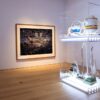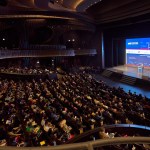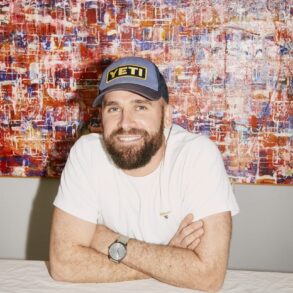On Tuesday, around 243 galleries returned to the Hong Kong Convention and Exhibition Centre for this year’s edition of Art Basel. For the first time since 2020, the fair, which runs until March 30, has returned to its pre-pandemic size, rising by 37 percent compared to last year. Around 10 percent of the fair’s exhibitors are showing in Hong Kong for the first time.
Some of the excitement surrounding the fair and the programming around the city’s West Kowloon Cultural District has been tempered by Hong Kong’s newly instated security law, widely known as Article 23, which is aimed at curbing dissent. Experts have raised concerns about the law’s vague language, which many have claimed could give way to a legal system that will more closely resemble the one seen in mainland China.
But the law seemed to have little impact on commerce during the VIP day of Art Basel Hong Kong, where dealers said they sold work early on. A Hauser & Wirth spokesperson told ARTnews that sales had been unexpectedly “brisk.”
Things are slower in China, said Marc Payot, president and senior partner of Hauser & Wirth, which just moved to a prime street-level space in Hong Kong’s Central Business District this past January. That wouldn’t have happened if there weren’t an active base of buyers in the city.
This year, of the 16 works that the gallery said it had sold by Tuesday evening, 10 went to collections in Asia. “We take this region very seriously and just opened a new space here, so it’s a huge investment,” Payot told ARTnews.
Painting, as usual, sold particularly well. Hauser & Wirth sold Mark Bradford’s painting May the Lord be the first one in the car… and the last out (2023) and Ed Clark’s Homage to the Sands of Springtime (2009) for $3.5 million and $1.1 million, respectively. These were already solid numbers—the Clark figure is just above the artist’s public auction record. But then those sales were followed by ones for a $9 million Willem de Kooning painting and an $8.5 million Philip Guston painting. Compare that to last year, when the gallery’s most expensive work was a George Condo painting that sold for $4.75 million.
Things appeared to be off to a slower start pretty much everywhere else. In a nearby booth, Brussels-based gallery Xavier Hufkens had on offer a painting by Milton Avery. As of press time on Tuesday, the $1.6 million canvas had yet to find a buyer. It was one of the few works with a seven-figure price at the fair.
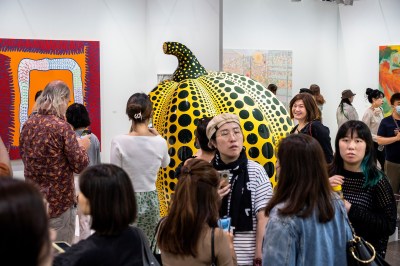
The crowd at Art Basel Hong Kong.
Photo Sebastian Ng/SOPA Images/LightRocket via Getty Images
Brett Gorvy, a founder Lévy Gorvy Dayan gallery in New York, told ARTnews that in the fair’s opening hours they’d sold five works each for prices under $500,000. (He declined to specify which artists had produced those works, saying only that they were on the gallery’s roster.) A large-scale red dot painting by Yayoi Kusama was the booth’s central work. Gorvy said the gallery had priced the piece at $4.8 million, but so far, no one had bought it.
Pace, which has operated in Hong Kong for over 15 years, reported that it sold 15 works by artists across its roster, including ones by Adam Pendleton, Kylie Manning, and Maysha Mohamedi. Out of the grouping that it displayed in the fair, just four of those works sold for prices above $100,000. The Pendleton, a 2023 painting titled Black Dada (D), brought in the highest price of the sold works, going for $275,000.
Los Angeles–based dealer David Kordansky reported selling a total of 17 works on the first day. Five of them, works by Joel Mesler to Shara Hughes, went for prices north of $100,000.
Whether or not big sales always resulted on opening day, a range of collectors were on hand during the preview, many with plans to buy actively. In a call with ARTnews ahead of the fair, Fabien Fryns, a Belgian collector who also works as an art adviser in Beijing, said that he’d be in “discovery mode” at the fair, looking for fresh artists who are in the early stages of their careers. Fryns pointed out that Art Basel has claimed a particularly large quotient of visitors at last year’s Hong Kong fair were young, and this, he said, syncs up with a trend he’s observed in his own private sales. Many of his Asian clients who focus on contemporary art are younger than 30. That’s a situation quite unlike what was seen in the mid-2000s, when collectors based in Asia tended to be in their mid-50s.
In the last several months, Fryns said commerce in the region has slowed significantly, and that the shift has put entrepreneurs in a state of restraint. “The business class is sitting idle,” he explained. “They’re holding off at the moment.”
Some younger buyers said they planned to be more conservative with their spending this year. Johnny Lee, who runs CCC Art Lab, a Japanese company that produces art books and events, told ARTnews he and a collector friend accompanying him were avoiding buying editioned works by KAWS and Daniel Arsham. Once popular among young collectors in Asia, these works are now seen to be overpriced. He said they were each more focused on finding “more affordable” pieces that fit with the decor of their respective lifestyles.
Gorvy praised the mix of young and old collectors in Hong Kong, which he said is different than what’s seen in Basel or even Paris, where Art Basel also mounts fairs each year. Coming out of the first day, he said there is “a feeling that there is new blood.”
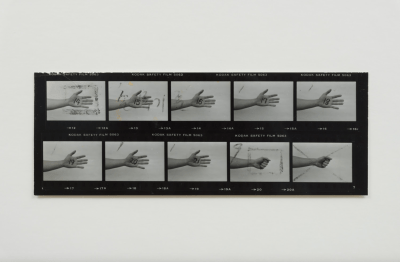
Sung Neung Kyung, Hand – contact print, 1976. Courtesy the artist and Lehmann Mauphin.
High attendance among younger visitors does not always translate to sales among more practiced collectors, who tend to be older. And more established collectors may not jump at making purchases, anyhow. “There’s a certain caution. Things are taking more time,” said Shasha Tittmann, a Hong Kong–based Lehmann Maupin director.
“Collectors are making very considered choices,” said Dawn Zhu, the Asia director at blue-chip European gallery Thaddaeus Ropac. Zhu contended that sales showed “positive” signs on the first day and reported that the top work the gallery sold was an untitled painting from 2023 by Martha Jungwirth, which had an asking price of €450,000 ($487,000). In Asia, the gallery has been working hard to expand its footprint—the Seoul space opened in 2021 with the aim of gaining a foothold in a city commonly positioned as a competitor to Hong Kong within the art world. It seemed as though the bet paid off this week—even if the gallery’s namesake owner was not in attendance at the fair.
Elsewhere, longtime locals secured deals alongside the bigger players. Katie de Tilly, who has run the Hong Kong–based gallery 10 Chancery Lane for two decades, told ARTnews that in the opening hours of the fair she’d sold one work by Vietnamese artist Dinh Q. Lê for $65,000 to a collector based in Europe. Rebutting anecdotal information that commerce has slowed in Asia, she said there is a highly active scene in places like Shenzen, which are less visible to Westerners.
De Tilley maintained that there are a lot of young working Chinese artists who have big followings locally. This means there is far less pressure on them to exhibit in European fairs for exposure. But their absence at large-scale trade events like this one, she said, makes it sometimes harder to discover them. She added, “The first half of 2023 was really slow—there wasn’t much of an audience—but things are picking back up.”



